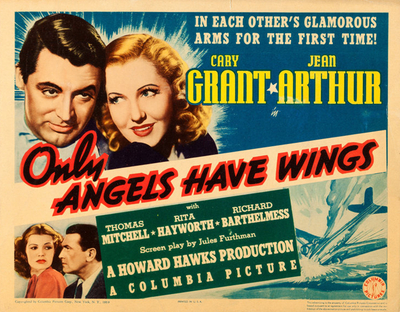In the book Hawks on Hawks, writer Joseph McBride's 1982 collection of interviews with Howard Hawks, the director says that he wanted to get the rights to Ian Fleming's Bond series, but that he was scooped by Cubby Broccoli, his former assistant director. When I read that, I spent twenty giddy minutes trying to imagine the alternate universe where Howard Hawks produced or even directed From Russia With Love, Goldfinger and On Her Majesty's Secret Service. I'm still not sure if it would have been a better place, but the closest we ever got to seeing that world is his 1939 adventure film Only Angels Have Wings.
The movie came out in Hollywood's magic year of 1939, alongside The Wizard of Oz, Gone With the Wind, Stagecoach, Of Mice and Men and Mr. Smith Goes to Washington, but also near the beginning of a winning streak of pictures by Hawks that included Bringing Up Baby, His Girl Friday, Sergeant York, Ball of Fire, To Have and Have Not, The Big Sleep and Red River. You can't complain about a film made by one of Hollywood's greatest directors, in the middle of the studio system's creative renaissance, but it's often overlooked in the context of both Hawks and Hollywood.
It's a drama, it's a romance, it's a comedy, but most of all it's a fantasy, set in probably the most resolutely Hawksian place the director ever created. It's a soundstage world, filled with characters, themes and events drawn from Hawks' own rather incredible life, and the two hours you spend there is among the best escapes from reality a movie can offer.
Over a shot of a cargo ship emerging from night and fog, a title card informs us that we're in "Barranca – Port of call for the South American banana boats." There is a port called Barranca in Peru, just outside Lima, but it's on that country's long, arid desert coastline and in no way resembles the lush, sweltering, rainy place where Jean Arthur's showgirl Bonnie Lee gets off the boat to stretch her legs and look for souvenirs. The Barranca Hawks and screenwriter Jules Furthman (Shanghai Express, Mutiny on the Bounty, The Outlaw) create for the film is (barely) carved out of the jungle, at the foot of the Andes, and if it's any place it might be at any point on the coastline from Ecuador to Curaçao.
As director Walter Hill described it to critic Michael Sragow for an essay about the film, "you're in this artificial universe – phony sets, phony jobs, like the guy in charge of watching for condors! But it's really about a worldview, and about codes of honor between men and women, and men and each other."
"One more quick thing," Hill adds. "Here we are, a tight little group, and it's dark out there, and ultimately we are alone, saved only by the grace of the human spirit: friendship, sex, courage . . . Wonderful film."
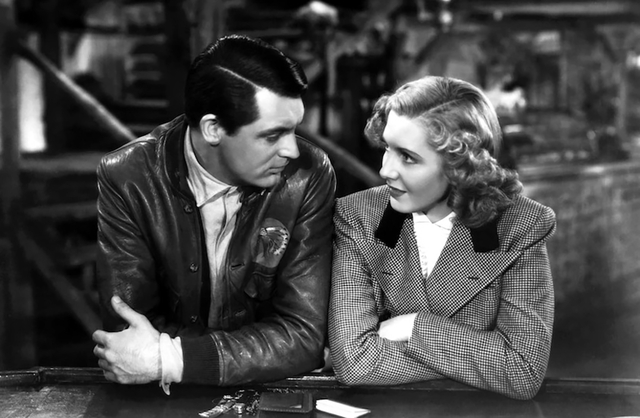
Bonnie immediately catches the eye of Les (Allyn Joslyn) and Joe (Noah Beery Jr.), two pilots flying mail and freight over the mountains for a struggling airline managed by Geoff Carter (Cary Grant). She's plenty savvy about men but intrigued by this motley crew of flyers and the bar/restaurant/hotel/post office/airstrip they're based out of, and takes them up on their offer of a steak dinner, the flyers drawing lots to see who gets to be Bonnie's dinner partner. Joe wins, but Geoff reminds him that he can't get out of his turn in the cockpit that easily.
Joe goes up in his plane, but bad weather in the only flyable mountain pass sends him back to the airstrip. Geoff tells him to circle until the weather clears, but he wants to make it back for dinner so desperately that he comes in too low, clips a wing on a tree and dies in the crash. Everyone reels from the shock, but Geoff and the rest of his crew seem to snap out of it too quickly for Bonnie. She tearfully asks them how they can be so callous, and how Geoff can blithely tuck into the steak Joe ordered just minutes before.
"Who's Joe?" they ask her.
The young Howard Hawks was a daredevil. He began racing cars in his teens, and claimed in Hawks on Hawks to have built a car that won at Indianapolis. He met his best friend, fellow director Victor Fleming, while racing cars:
"I put him through a fence and wrecked his car. I won the race and saw him coming; I thought I was gonna have a fight with him. Instead of that, he came up with a grin and he said, 'That was pretty good, but don't ever try it again, because I'll just run into you.' We became very good friends. He came up to my house for a while when he was looking for a place, and he stayed five years."
Hawks became a pilot during World War One, flying for the US Army Signal Corps, and as a barnstormer after the war. His younger brother Kenneth also flew, and was a promising director in Hollywood before he died when two camera planes crashed while making his second picture, the presciently-titled Such Men Are Dangerous, in 1930.
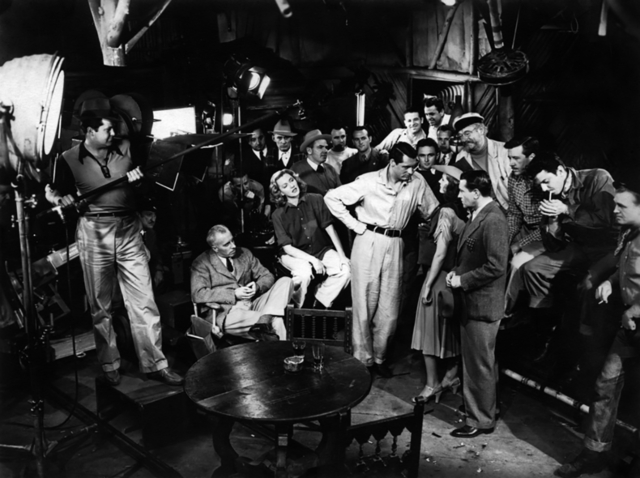
In the context of the best films Hawks made in the '30s and '40s, Only Angels Have Wings is practically an epic, but he always insisted that it was inspired by real life. The flyers and crew centred around Grant's Geoff in Barranca are the sort of manly group/gang/family that he'd feature in many films, like the bomber crew in Air Force, the hunters in Hatari!, and the cowboys in Rio Bravo, El Dorado and Rio Lobo. In spite of her best instincts, Bonnie has become infatuated with Geoff and decides to stick around and wait for the next boat, but it's just as likely that she's fallen for the grim camaraderie of the flyers.
When the film was released, a critic said that Hawks' pictures were usually realistic, but that with Only Angels Have Wings he "went too far."
"I wrote him a letter and said that there wasn't one single scene in the whole picture that wasn't real. I told him how I got the idea for the story at a party one night. I was with a Mexican bush pilot. We were flying around Mexico landing in washes and having a lot of fun." Hawks recalled a story the pilot told him about a beautiful girl married to "a fellow with a burnt face and great eyes."
He also remembered meeting a pilot who jumped out a burning plane and left someone behind who died in the crash. "He spent the rest of his life trying to make up for that, and he got killed, finally, trying to make up for it."
"I knew every character personally that was in that picture," Hawks told McBride. "I knew how they talked."
This is probably why the dramatic centre of the film isn't really with Grant and Arthur but between Grant and Richard Barthelmess' Bat MacPherson, the pilot who jumped out of the burning plane, leaving his mechanic behind to die. He turns up on the next boat after Joe dies, having changed his name and bringing along his wife Judy (Rita Hayworth, in the role that finally made her a star), a former flame of Geoff's.
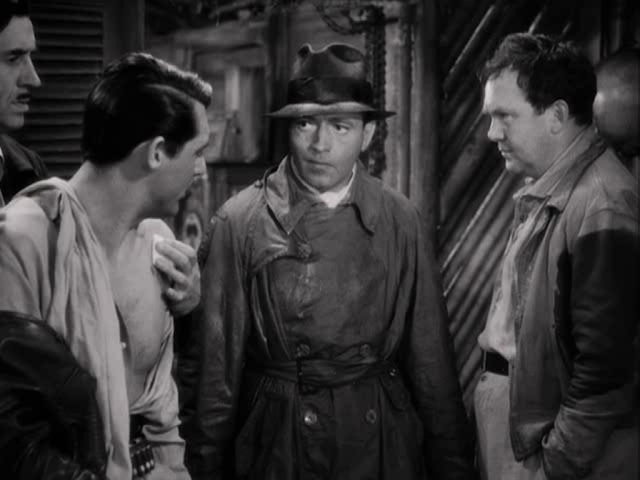
Barthelmess had been a huge star in the silent era, and had worked with Hawks on The Dawn Patrol (1930), another film about flyers, but his career had stalled during the '30s, and he'd had botched plastic surgery that left scars beneath his eyes. Hawks clearly knew what this silent movie legend could do, and his Bat is brooding, barely blinking, his eyes wary and wounded – a man who knows that he's on probation, relegated by Geoff to the most dangerous jobs. It would be one of Barthelmess' last roles; he enlisted in the US Navy Reserves during the war, and never went in front of a camera again.
As for Hayworth, she was at the end of a long process that turned her from a dancer and Latin exotic into one of the greatest sex symbols of Hollywood's golden age, funded and overseen by Columbia studio boss Harry Cohn. "When she finished the picture," Hawks said, "Harry Cohn said to me, 'Anything you want – a boat or a racing car – it's yours. I got a new star."
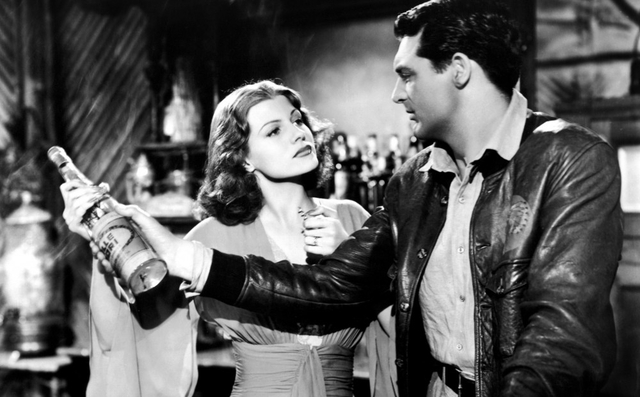
"She never was a great actress," Hawks recalled, "but she certainly was a beautiful girl." Indeed, one of the most fantastical aspects of the film is that Geoff is caught between Rita Hayworth and Jean Arthur. Even for a man played by Cary Grant, it's an envious place to be. But despite this implied romantic triangle, ultimately Only Angels Have Wings isn't a particularly great Grant or Arthur picture, though it's a fantastic Hawks movie.
The director had particular difficulty with Arthur, who resisted his instructions on the character of Bonnie, apparently trying to get the actress to play her more sexy. "She didn't fit into the kind of girl that I liked," Hawks told McBride.
"She was afraid to try anything on the spur of the moment. When the picture was over I said, 'Jean, I think you're the only person I've ever worked with that I don't think I helped a bit. Some day you will see in a picture what I wanted you to play.' Then one time I came home, and there was a car in the driveway. Jean was in the back seat. She said, 'I saw To Have And To Have Not. I wish I'd done what you'd asked me to do. If you ever make another picture with me, I promise to do any goddam thing you want to do. If a kid can come in and do that kind of stuff, I certainly could do it.' I said, 'I know you could.'"
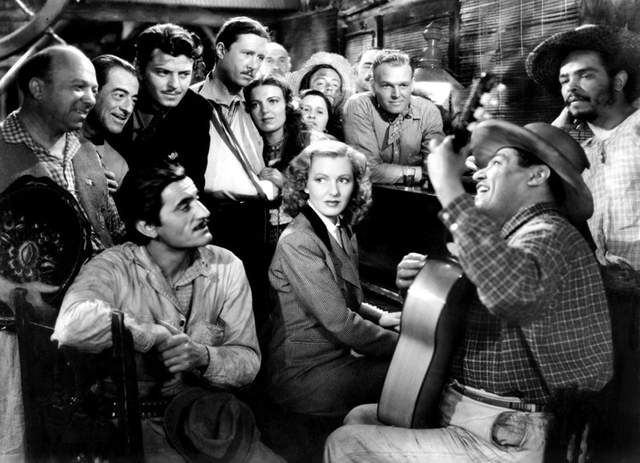
Hawks was more successful creating the world of Barranca, and the social hot spot that doubles as an airport. It's a classic jungle outpost soundstage set, with rough-hewn beams and woven walls meant to look like they're scavenged from the nearby rainforest. And then there's the flyers with their leather flight jackets, rumpled khakis and big pistols hanging off their hips in low-slung tooled and studded holsters.
In a blog post devoted to Grant's wardrobe – and his 37J1 flight jacket (a variation of the classic A1 pilot's jacket, produced the US Army Air Corps after World War One) – it's pointed out that his whole outfit, accessorized with a beat-up fedora, would appear decades later on Harrison Ford's Indiana Jones.
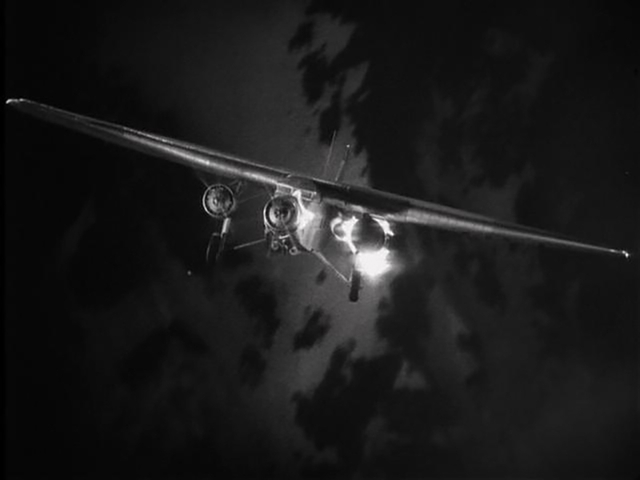
As a flyer, Hawks took great care with the film's special effects – a medley of miniatures, matte paintings and practical shots with real planes – and the accuracy of the aircraft and flying shown onscreen. This is the ramshackle, experimental period between the wars, when aviation (just thirty-five years after the Wright Brothers' first flight) was trying to perfect the propeller plane. There's still a biplane in the hangar at Barranca (a Boeing Model 40, perhaps a Model 100) but most of the planes are high-winged monoplanes covered with struts and corrugated metal skin, like the Ford Tri-Motor that Barthelmess flies near the end. Hawks took so much care with the flying scenes that the film is valued as a rare document of pre-war aviation today.
Like so many Hawks movies, Only Angels Have Wings is very nearly an ensemble picture, with the stars embedded into a cast that adds not just colour but depth to the story and the drama. This is particularly true of Thomas Mitchell's Kid, Geoff's middle-aged right-hand man, and the brother of the mechanic Bat left to die in the plane.
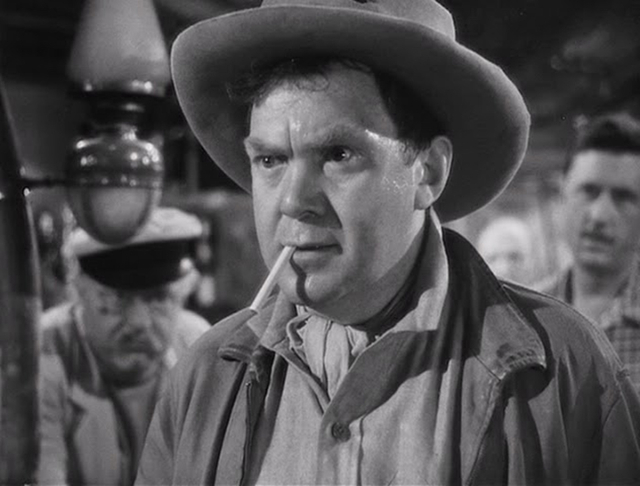
Besides his beef with Bat, Kid has to deal with his failing eyesight, which forces Geoff to ground him after over twenty years of flying. The older man gets drunk, but sucks up the blow with the same stoicism that the group values and Hawks esteems. He still talks himself into the co-pilot's seat next to Bat on the Tri-Motor, on the crucial final flight Geoff and the airline need to make to win a valuable contract that will save the airline.
Flying through the treacherous mountain pass, the plane collides with a flock of condors, one of whom crashes into the cockpit and breaks Kid's neck. With two of the Ford's three engines on fire, Bat refuses to bail out even after Kid tells him to, and takes the plane in for a rough crash landing, his own face burned by the flames from the engines.
Kid is carried from the wreck, but he knows he's a goner, and whispers his final wish to die alone to Geoff in a hushed, intimate scene. "It's like doing something new," Kid tells him. "It's like when I did my first solo – I didn't want anyone watching then, either."
"I've seen people die, you know," Hawks told McBride. "Well, I saw a fellow die once. He was in a plane wreck with his best friend. He said 'I kinda feel funny.' The guy said 'Your neck's broken.' He was very quiet and he said, 'I've thought for a long time just how I'd act with it was all over. I don't know how good I'm gonna be.' And he said, 'Yeah.' So we all left and he died. I used that in Only Angels Have Wings, I used it again in Rio Lobo. That's a good dying."
Before he dies, Kid forgives Bat, and that lets the other flyers accept him, a second chance bought with a second death. It's doubtful that most people could understand the code that Hawks' characters live by, though it's obvious that audiences could once imagine that they could – a fantasy that Hawks probably didn't imagine, even if his film encouraged it.
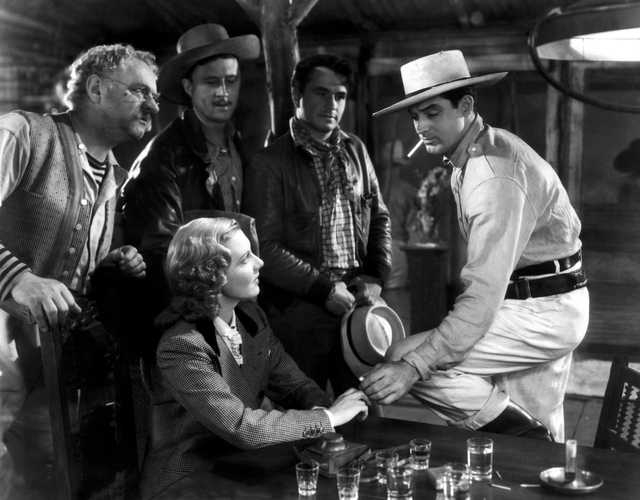
It's a trope to say about any film made before ten years ago that "they don't make them like that anymore." (It's a threshold that keeps getting shorter – I remember when it was forty, then thirty, then twenty.) But it's certainly true with any Hawks film, and Only Angels Have Wings in particular, with its cast of men who deal with trauma by ignoring it. Even more improbable is suggesting that a character can show cowardice and fear and still earn redemption; our fantasies today favour punishment and revenge.
Howard Hawks died in 1977, and though Rio Lobo was his last film, he was still trying make new movies during the last years of his life. There was a "crazy, wild comedy" about the oil business, which attracted the interest of Steve McQueen and Clint Eastwood, and a Vietnam War film, neither of which got made. Asked if he wanted to make a "statement about the war," Hawks was unequivocal: "I've never made a statement. Our job is to make entertainment. I don't give a God damn about taking sides."
Mark Steyn Club members can let Rick know what they think by logging in and sharing in the comments below, as access to the comments section is one of many benefits that comes along with membership in the Mark Steyn Club.


